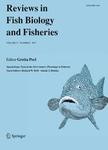版权所有:内蒙古大学图书馆 技术提供:维普资讯• 智图
内蒙古自治区呼和浩特市赛罕区大学西街235号 邮编: 010021

作者机构:Department of Fisheries and Marine Biology University of Bergen Bergen High Technology Center Bergen Norway Department of Fisheries and Marine Biology University of Bergen Bergen High Technology Center Bergen Norway Department of Fisheries and Marine Biology University of Bergen Bergen High Technology Center Bergen Norway
出 版 物:《REVIEWS IN FISH BIOLOGY AND FISHERIES》 (鱼类生物学和渔业评论)
年 卷 期:1998年第8卷第4期
页 面:491-491页
核心收录:
学科分类:0710[理学-生物学] 0908[农学-水产] 07[理学] 071004[理学-水生生物学]
主 题:adaptation artificial neural networks fish fitness game theory genetic algorithms hearing ideal free distribution learning life history theory memory migration olfaction optimal foraging theory optimization sensory organs spatial modelling stochastic dynamic programming vision
摘 要:Our ability to model spatial distributions of fish populations is reviewed by describing the available modelling tools. Ultimate models of the individual‘s motivation for behavioural decisions are derived from evolutionary ecology. Mechanistic models for how fish sense and may respond to their surroundings are presented for vision, olfaction, hearing, the lateral line and other sensory organs. Models for learning and memory are presented, based both upon evolutionary optimization premises and upon neurological information processing and decision making. Functional tools for modelling behaviour and life histories can be categorized as belonging to an optimization or an adaptation approach. Among optimization tools, optimal foraging theory, life history theory, ideal free distribution, game theory and stochastic dynamic programming are presented. Among adaptation tools, genetic algorithms and the combination with artificial neural networks are described. The review advocates the combination of evolutionary and neurological approaches to modelling spatial dynamics of fish.